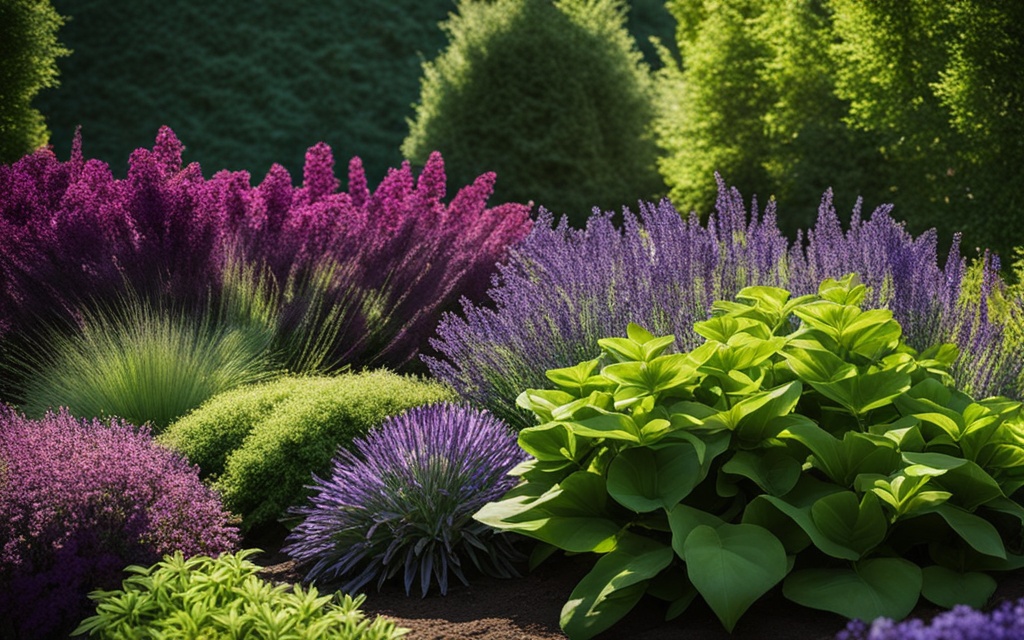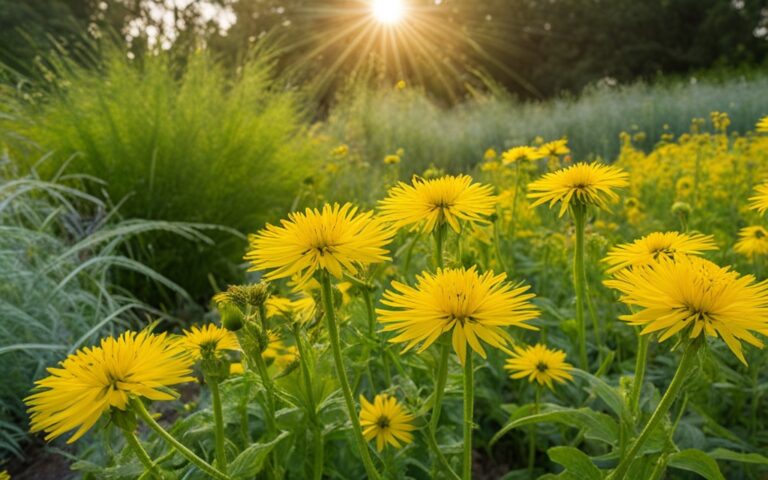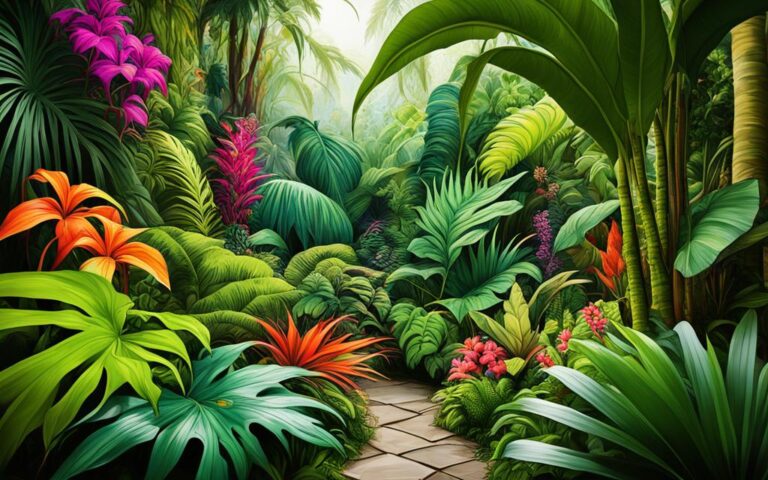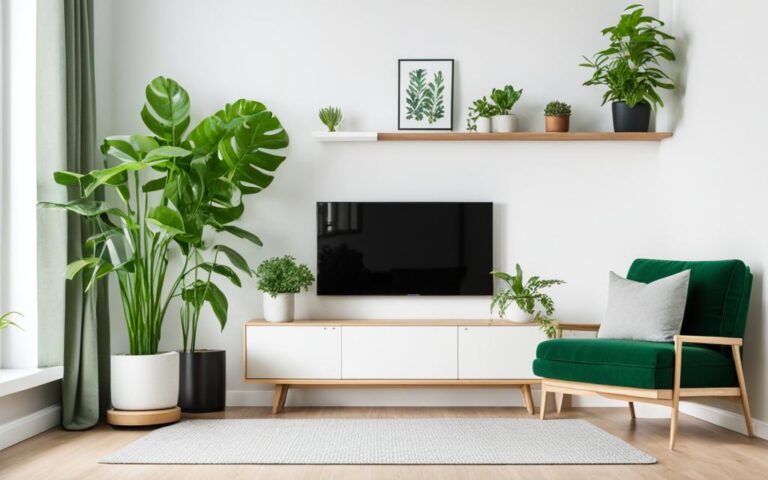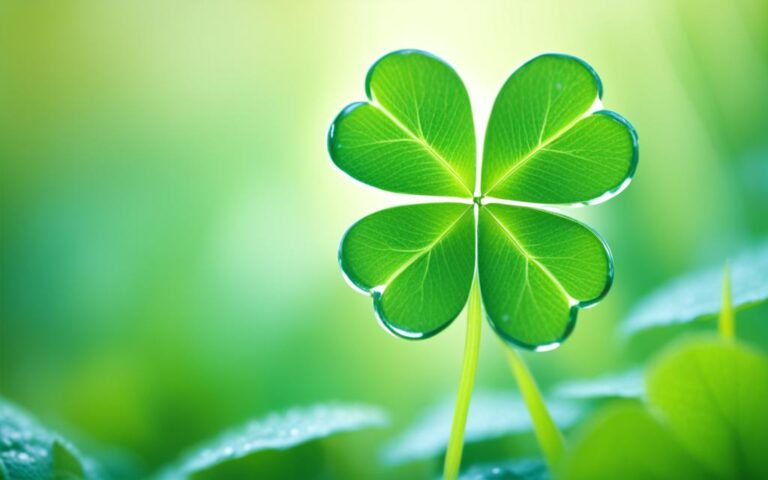Purple Plants: Vibrant Blooms for Your Garden
Did you know the purple plant market could hit $2.5 billion by 2025? These stunning colors are becoming a favorite among gardeners and designers. They add elegance and sophistication to any outdoor area. From the majestic lavender flowers to the striking purple leaves, purple plants stand out.
If you’re new to purple plants or already love them, this article is for you. It will show you how to bring these vibrant blooms into your garden or landscape. Get ready to see how purple plants can make your outdoor space more beautiful and inviting.
Key Takeaways
- The global purple plant market is projected to reach $2.5 billion by 2025, reflecting their growing popularity.
- Purple plants offer a wide range of colors, from light lavender to deep violet, adding depth and sophistication to any garden.
- These vibrant blooms can be used in a variety of garden styles, from formal to cottage-inspired, to create stunning color combinations.
- Purple plants thrive in various USDA Growing Zones, making them adaptable to different climates and regions.
- Incorporating purple plants into your landscape design can elevate the overall aesthetic and provide a visually captivating focal point.
Introduction to Purple Plants
Importance and Popularity
Purple plants are a favorite in gardens for their regal look and feel. They add drama and elegance to any outdoor space. Gardeners love them for their ability to make gardens look stunning.
These plants come in many colors, from soft lavenders to bold purples. They can be used to create beautiful color schemes and eye-catching spots in the garden.
Interesting Facts
Purple plants have a rich history and unique traits that make them special. The color comes from anthocyanin, which helps the plants grow. This pigment can change depending on the environment, creating different shades of purple.
Many purple plants, like lavender and heliotrope, have fragrant flowers that attract bees and butterflies. This adds to the garden’s sensory appeal. Their association with royalty has made them popular in gardens for centuries.
| Plant Name | Height | Origin |
|---|---|---|
| Aster novae-belgii | 3-6 feet | Perennial |
| Cosmos | Annual | Easy Cultivation |
| Salvia, Geraniums, Liatris, Phlox, Verbena bonariensis | Perennials | Attract Pollinators |
| Lisianthus Select Purple, Yellow Carnations, Yellow Roses, Ruscus, Hypericum, Aster Monarch Purple, Aster Golden Glory | Bouquet Flowers | Symbolize Love, Positivity, Strength, or Joy |
The Aster novae-belgii, or purple Aster, symbolizes royalty and wisdom. It grows three to six feet tall and attracts birds and butterflies. It does well in various conditions, making it a favorite among gardeners.
Cosmos is an annual plant that’s easy to grow. It blooms from summer to autumn and can self-sow in warm areas.
Salvia, Geraniums, Liatris, Phlox, and Verbena bonariensis are great for adding purple to gardens. They attract pollinators and bring vibrancy to any garden.
For purple bouquets, consider Lisianthus Select Purple, Yellow Carnations, Yellow Roses, Ruscus, Hypericum, Aster Monarch Purple, and Aster Golden Glory. These flowers symbolize love, positivity, strength, or joy.
Common Purple Plant Species and Varieties
The world of purple plants is full of life and beauty. It includes everything from the famous lavender to the striking aster and the timeless lilac. These plants are favorites in gardens, adding color and a sweet scent. Let’s look at some top purple plant choices.
Lavender
Lavender is a top pick for its lovely purple flowers and leaves. It’s part of the Lavandula family. You can find different types like English lavender (Lavandula angustifolia) and French lavender (Lavandula dentata). These plants grow in various shapes, from small bushes to tall plants. They’re great for gardens, landscaping, and even cooking and making perfumes.
Aster
Asters, known as Symphyotrichum, are known for their bright purple flowers. They look like daisies and are perfect for adding color in the fall. You can find asters in many purple shades, from light to deep violet. They’re great for borders, cut flower gardens, and natural areas, adding color when other plants are fading.
Lilac
Lilacs, in the Syringa family, are famous for their purple (or white) flowers and sweet smell. They bloom in spring and are often used in gardens. Lilacs come in various purple shades, from soft lavender to deep purple. Some lilacs, like the ‘Bloomerang’ series, bloom for a longer time, adding color and scent to your garden.
| Plant | Growing Zones | Height | Sunlight | Soil Preference |
|---|---|---|---|---|
| Lavender | 5-9 | 12-36 inches | Full sun | Well-drained, alkaline |
| Aster | 3-8 | 12-36 inches | Full sun | Well-drained, moist |
| Lilac | 3-7 | 6-15 feet | Full sun | Well-drained, slightly acidic |
Anatomy and Characteristics
Purple plants show off a wide range of physical traits, from their beautiful leaves to their eye-catching flowers. Many purple plants have leaves that go from deep purple to soft lavender shades. Their stems can also be purple, adding to their look. The flowers of these plants are especially striking, showing off a variety of purple shades from soft to bright.
Description of Leaves, Stems, and Flowers
The leaves of purple plants come in different sizes, shapes, and textures. For example, the purple coneflower has big, lance-shaped leaves that feel rough. On the other hand, lavender has long, thin leaves that are soft and velvety. The stems of these plants can be deep purple or a reddish-purple shade.
The flowers of purple plants really stand out. Salvia and Verbena have bright, colorful blooms. Heliotrope flowers are more delicate and smell great. These flowers have special parts like petals and stamens that help them attract pollinators and reproduce.
Special Features
Purple plants are not just pretty; they have special features too. The color comes from anthocyanin, which helps the plant grow and thrive. Plants like Salvia and Verbena attract hummingbirds, butterflies, and bees, which is good for the environment. Lavender and Heliotrope are also known for their fragrant flowers, adding another layer of enjoyment to gardens.
Purple plants are valuable and versatile in gardens or landscapes. They bring beauty and help the environment with their unique features. From their striking leaves to their beautiful flowers, they make any outdoor space more vibrant and diverse.
purple plants
The world of purple plants is full of options for gardeners and designers. It includes everything from tall shrubs to vines that cascade. Each type of purple plant can add depth and drama to your garden plants or landscaping plants.
At the small end, annuals like petunias and calibrachoas burst into vibrant purple flowers. Perennials such as asters and geraniums last longer. Vines like clematis and verbena can spill over walls or containers, adding a romantic touch.
For height, shrubs like lilacs and azaleas stand tall. Plants like Alternanthera, Oxalis, and Tradescantia add deep colors. Bulbs like crocuses and alliums bring color in early spring, while chrysanthemums and dahlias bloom late into autumn.
| Plant Variety | Growth Habits | Ideal Growing Conditions |
|---|---|---|
| ‘Dark Side of the Moon’ Astilbe | 1 to 4 feet tall and wide | Zones 3-9, partial shade |
| Pearl Glam® Beautyberry | 4 to 5 feet tall, 3 to 4 feet wide | Zones 5-8, full sun to partial shade |
| ‘Black Scallop’ Bugleweed | 6 to 8 inches tall, 24 inches or more wide | Zones 3-10, full sun to partial shade |
| ‘Wyoming’ Canna | 1-1/2 to 8 feet tall, 1-1/2 to 6 feet wide | Zones 7-11, full sun |
| ‘Black Prince’ Coleus | 6 to 26 inches tall and wide | Zones 10-11, partial shade to full sun |
Purple plants fit into many garden styles, from formal to cottage-style borders. They are great for making your outdoor space look beautiful and put together.
“The beauty of purple plants lies in their ability to add depth, drama, and a sense of regal elegance to any garden or landscape.”
Ideal Growing Conditions
To grow vibrant purple plants, it’s key to know their light, temperature, humidity, soil, and watering needs. Many purple plants like salvia and petunia love full sun, needing at least six hours of sunlight daily. On the other hand, some like lamium and columbine do well in partial shade, especially when it’s very hot.
Light Requirements
Not all purple plants like full sun. Finding the right balance is important for their growth. Make sure to check each plant’s specific light needs to help them thrive.
Temperature and Humidity Needs
Purple plants can handle different temperatures and humidity levels, but each has its own needs. For example, lavender and petunias do well in warm, dry places with enough moisture. But, pansies and violas prefer cooler weather and may not like the heat and humidity as much. Knowing the best growing zones for your purple plants is key to their health and success.
Soil and pH Preferences
The soil for purple plants can be slightly acidic to slightly alkaline, depending on the type. Many, like azaleas and hydrangeas, love acidic soils with a pH of 5.5 to 6.5. Others, like lavender and thyme, prefer soils closer to neutral or slightly alkaline, around pH 7.0. Adding the right soil amendments, like compost or lime, can help your purple plants grow well.
Watering Needs
Purple plants have different watering needs. Some, like lavender and salvia, are pretty drought-tolerant and like well-drained soils. Others, such as petunias and calibrachoas, need more moisture to stay healthy and blooming. Using deep, infrequent watering can prevent problems like root rot in the more sensitive types.
Knowing the specific needs of your purple plants helps you create the best conditions for them. This way, you can enjoy their beauty and vibrant colors in your garden.
Propagation Methods
Gardeners have many ways to grow more vibrant purple plants. They can use seeds, cuttings, or division. Each method has its own benefits and things to consider.
Annual purple plants like petunias and calibrachoas grow well from seed. This lets gardeners mix colors and try new types. Perennials like lavender and asters can be split and replanted, or divided.
Some purple plants, like salvia and verbena, can be grown from cuttings. This means taking a piece of the stem, rooting it, and making a new plant. Knowing how to propagate each type of purple plant is key for gardeners.
| Propagation Method | Ideal Timing | Key Considerations |
|---|---|---|
| Seed Propagation | Spring and Summer |
|
| Cuttings | Spring and Summer |
|
| Division | Spring and Fall |
|
Learning these propagation methods helps gardeners grow more purple plants. It also lets them share their love for gardening with others.
Care and Maintenance
For purple plants to thrive in the garden, proper care and maintenance are key. This includes pruning and training, which depend on the plant type. It’s about removing dead flowers, thinning out crowded areas, and shaping the plant to keep its desired look.
Pruning and Training Techniques
Lavender plants do well with regular trimming to stay neat and compact. Clematis vines need support to grow up a trellis. Some plants like salvia and petunia benefit from deadheading to keep them blooming longer. Using the right pruning and training for each plant helps them stay healthy and look great in the garden.
Pest and Disease Management
Purple plants can face pests and diseases, hurting their health and looks. Gardeners can fight these issues with integrated pest management. This includes using beneficial insects, organic controls, and keeping the garden healthy. Watching for pests and diseases early and acting fast can keep purple plants thriving.
Fertilizers and Nutrients
Feeding purple plants the right fertilizers is key for their growth and color. Many species, like petunias and salvias, do well with regular water-soluble fertilizers. Slow-release fertilizers can be added to the soil at planting time for steady nutrients. Some plants, like azaleas and hydrangeas, need special fertilizers for their soil type. Knowing what each plant needs helps gardeners keep their purple plants looking their best.
| Plant Species | Watering Needs | Lighting Requirements | Mature Size |
|---|---|---|---|
| Purple Oxalis | Every 1-2 weeks | Full sun | 6-12 inches tall |
| Lavender | Every 10-14 days | 4-6 hours of direct sun | 24-36 inches tall |
| Prayer Plant | Every 1-2 weeks | Partial shade | 12-18 inches tall |
| Rex Begonia | Weekly when soil dries | Partial shade | 12-18 inches tall |
| Purple Coleus | Regular watering | Partial shade | 12-18 inches tall |
Benefits of Growing Purple Plants
Growing a garden with purple plants brings many benefits. They make any outdoor space look elegant and sophisticated. Their beauty adds drama and a sense of wonder.
Purple plants are great for making focal points in the garden. They add depth and contrast, tying together different colors. Many purple plants, like salvia and lavender, attract bees and butterflies. This helps create a healthy garden ecosystem.
These plants come in different types, each with unique growth habits and bloom times. Gardeners can use them to make their spaces look beautiful and support nature.
- Purple plants are easy to care for and can handle dry conditions, perfect for busy people or dry areas.
- They help clean the air by removing harmful substances, making indoor spaces healthier.
- These plants help prevent soil erosion, keeping the garden stable and looking great.
- They grow thick and block weeds, cutting down on garden work.
- They draw in bees and butterflies, supporting local wildlife and making gardens better for nature.
| Benefit | Description |
|---|---|
| Ornamental Value | Purple plants brighten up spaces with their eye-catching colors, making them more beautiful inside and outside. |
| Versatility | These plants can grow well in different light and soil types, giving gardeners more design options. |
| Cultural Significance | Some purple plants have deep cultural and symbolic meanings, adding history and cultural value to gardens. |
Using purple plants in gardens and landscapes makes them look great, support nature, and have deep cultural meaning. Gardeners and designers can create spaces that are beautiful, sustainable, and meaningful.
Designing with Purple Plants
Purple plants add a unique and eye-catching touch to gardens and landscapes. They can be used in many color schemes, making outdoor areas look stunning. By using color theory, gardeners and designers can blend these plants smoothly into their designs.
Color Combinations
Pairing purple with yellow or orange creates bold, eye-catching displays. Using purple with blues and pinks makes for a calming effect. Adding purple as an accent color can highlight a green or neutral setting.
Knowing the different shades of purple is crucial for mixing colors. Blue-purple flowers are calm and elegant, while red-purples are lively and energetic. Mixing these shades can make garden designs stand out.
Companion Planting Ideas
Purple plants work well with many other plants to create beautiful groupings. Combining purple flowers with plants like silvery-green or chartreuse leaves adds visual interest. Using purple-leafed plants like Heuchera or Colocasia with bloomers creates a unified look.
Adding purple flowers with fragrant herbs or pollinator plants makes gardens thrive. Creative planting ideas let gardeners highlight purple plants’ beauty. This approach improves the garden’s look and function.
| Color Combination | Effect |
|---|---|
| Purple and Yellow | Bold, high-contrast |
| Purple and Blues/Pinks | Harmonious, soothing |
| Purple as Accent | Punctuates green or neutral palette |
| Blue-purple and Red-purple | Combines subdued and vibrant hues |
By using purple plants in different ways, gardeners and designers can make outdoor spaces beautiful. They can play with colors and plant combinations to highlight the unique charm of purple flowers.
Showcase: Stunning Purple Plant Varieties
Purple plants bring beauty and variety to gardens. From the sweet scent of lavender to the bright colors of petunias and dahlias, there’s a purple plant for every garden. Each one adds its own special touch to the landscape.
For small spaces, try the compact Superbells® Blue Moon Punch calibrachoa or Supertunia® Royal Velvet® petunia. They’re perfect for containers. For a bigger impact, consider the tall Rockin’® Deep Purple salvia or Primo® ‘Wild Rose’ heuchera. These plants can be the stars of your landscape design.
Other great purple plants include the Pugster Blue® butterfly bush, with its beautiful blooms. The Winecraft Black® smokebush has lacy leaves that add texture. And the Laced Up® elderberry stands out with its unique shape. These plants help create beautiful, cohesive gardens.
- Superbells® Blue Moon Punch calibrachoa: Compact, mounding variety ideal for containers and small spaces.
- Supertunia® Royal Velvet® petunia: Vibrant, bold flowers that add drama to the landscape design.
- Rockin’® Deep Purple salvia: Taller, eye-catching focal point plant for the garden.
- Primo® ‘Wild Rose’ heuchera: Dramatic, architectural plant that complements purple plant varieties.
- Pugster Blue® butterfly bush: Reblooming shrub that attracts pollinators and adds garden inspiration.
- Winecraft Black® smokebush: Lacy, unique foliage that enhances the landscape design.
- Laced Up® elderberry: Vertically inclined plant that adds vertical interest to the garden.
“Exploring this diverse array of purple plant options allows gardeners and designers to create visually stunning, cohesive, and captivating outdoor spaces.”
Conclusion
Purple plants bring a unique charm to gardens and landscapes. They range from the sweet-scented lavender to the bright, bold petunias and dahlias. These plants add beauty, depth, and a royal touch to any outdoor area.
They’re not just pretty to look at. Many purple plants help the environment by drawing in bees, butterflies, and hummingbirds. Adding purple plants to your garden can make it a peaceful retreat or a lively centerpiece.
When choosing purple plants, think about what they need to grow well. Consider their care and how they fit into your garden plan. With the right care, purple plants can make your outdoor space truly special.
